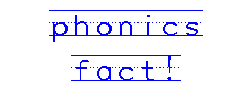Listen to Phonic Sounds
The 44 phonic sounds of our English Language consist of:
Listening to phonic sounds is important for developing your child’s language and literacy skills. By listening & becoming familiar with them, your child will realize that letters stand for the sounds they hear in words.
For example, being able to hear the differences between “cot,” “cat,” and “cut” is necessary for learning how to spell these words.
Ask your child’s teacher what phonic sounds they are learning each week (ask the teacher to write them down for you), so you can begin to point them out in your child’s reading books or read rhymes that contain them.
There are approx 44 sounds (phonemes) in our English Language which consist of Consonant and Vowel Sounds.
There are approximately 70 ways to spell these sounds, which your child & teacher will refer to as phonograms.
It is a good idea to become familiar with the sounds of our English Language because then you will be able to help your child say & spell their phonograms correctly.
Listen to Vowel Sounds
Listen to Consonant Sounds
Other useful phonics sounds sites:
Library of English Sounds
Use our lesson plans to help learn the phonics sounds
 Word Family Fun: 20 Short Vowel Word Family Books and Activities
Word Family Fun: 20 Short Vowel Word Family Books and Activities

cat, rake, tall, mare, alarm, mark
Also a phoneme (sound) can represent more than one grapheme (spelling). For example, notice the /f/ sound:
f (fig), ph (elephant), gh (cough)


Comments are closed.